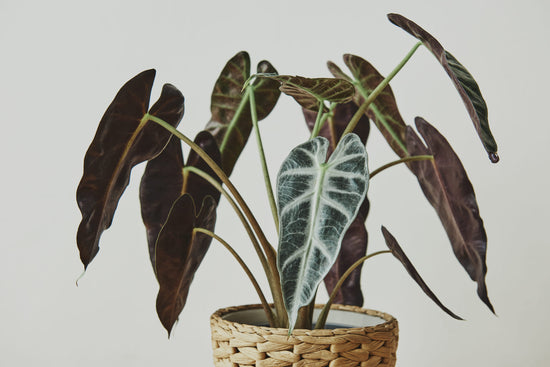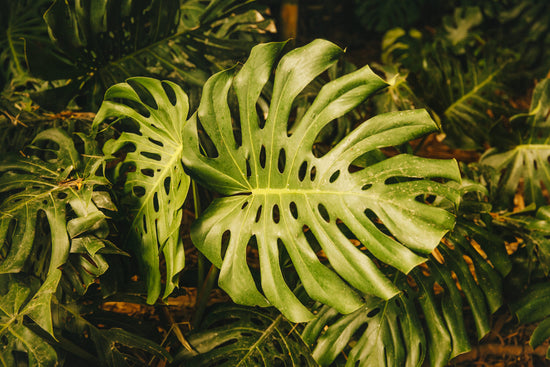Do you dream of a jungle at home? With a few simple tricks, you can successfully care for tropical plants. Here are tips for beginners to get closer to your green paradise.
Choose the right one
The world of tropical plants is fascinating, but it can also be overwhelming for beginners. The key is to start with the right plants that are easy to care for even for beginners.
Beginner-friendly option:
- Monstera (Swiss Swiss Cheese Plant) : The Monstera is not only an aesthetic eye-catcher with its slit leaves, but also extremely robust. It can cope with different lighting conditions and only needs occasional watering.
How do I recognize the right one?
-
Leaf structure: Choose plants with robust leaves that are not too sensitive to touch.
-
Light requirements: Consider the light requirements. Beginner-friendly plants often get by with indirect light.
-
Watering habits: Choose plants that do not require daily watering. Beginner-friendly plants often have a certain tolerance for irregular watering.
Choosing the right plant is the key to a successful start in tropical plant care.
Give them sun
Tropical plants are real sun worshippers. A bright spot with indirect light is perfect. The plants get their energy from the sun, and good light is crucial for their health and beauty. But be careful not to expose them directly to the midday sun - they don't like that very much.
The ideal location: Bright place with indirect light
-
Bright, indirect light: Place your tropical plants in a location with plenty of bright, indirect light. Mimicking their natural habitat where they are under tree canopies is ideal.
-
Avoid direct midday sun: Make sure your plants are not exposed to the scorching midday sun. Direct sunlight can cause burns and affect the well-being of your plants.
Signs of too much or too little light
-
Leaf discoloration: Yellow leaves can indicate too much sun, while dark, faded leaves can indicate too little light.
-
Growth direction: If your plant is growing on one side, it may be trying to reach more light. Rotate it occasionally to encourage even growth.
How much light is enough?
-
For high light requirements: Plants like the Ficus elastica or the Calathea need a little more light. A place near a bright window is ideal here.
-
For lower light requirements: Beginner-friendly plants such as the Sansevieria or the snake plant are less demanding and thrive even in rooms with less natural light.
Water, but not too much:
Proper watering is a key aspect of caring for tropical plants. Keep the soil evenly moist. Stick your finger into the soil before watering. It's better to give too little than too much water!
Even moisture: the key to success
-
Proactive moisture test: Stick your finger into the top layer of soil. If it is dry, it is time to water. However, avoid keeping the soil constantly moist as this can cause root rot.
-
Drainage is crucial: make sure pots have adequate drainage holes to avoid standing water. Stagnant water can encourage root rot.
Signs of too much or too little water:
-
Wilting leaves: If the leaves are limp, this could indicate too little water. However, wilting, yellow leaves could also indicate waterlogging due to too much water.
-
Discoloration of leaves: Dark, mushy roots or a musty smell indicate root rot, while dry, brittle leaves may indicate too little water.
When and how to water?
-
Morning preferred: Ideally, water your plants in the morning. This gives the soil enough time to dry during the day, which minimizes the risk of disease.
-
Avoid cold water: Use lukewarm water, especially in cold months. Cold water can damage the roots.
Consider specific needs:
-
Humidity lovers: Plants like the Calathea love humid conditions. Place a bowl of water near them to increase humidity.
-
Drought-resistant plants: Plants like the Sansevieria require less water. Allow the soil to dry out well between waterings.
Increase the humidity
Tropical plants love humidity. Place a bowl of water next to them or mist them regularly to increase the humidity.
The Art of Humidity: Why is it Important?
-
Mimic natural habitat: Tropical plants come from regions with high humidity. By recreating these conditions in your home, you promote their well-being and health.
-
Preventing leaf problems: Dry air can cause problems such as dry leaf edges, wilted leaves and increased pest infestation. Higher humidity protects against these undesirable effects.
How do I increase the humidity?
-
Water bowl or pebbles: Place a shallow bowl of water next to your plants. Alternatively, pebbles in a bowl of water can increase evaporation.
-
Regular spraying: Spray your plants regularly with water. Make sure the water is at room temperature to avoid shock effects.
Give them food
Fertilizer is like a vitamin boost for plants. Give them some fertilizer now and then, especially in spring and summer. Then they'll grow out of control even faster!
Why is fertilization important?
-
Replenish nutrients: Over time, the soil in the pots uses up the nutrients available. Fertilizer replenishes these important elements and ensures healthy plant growth.
-
Promote flowering: A well-balanced fertilizer not only supports growth, but also promotes flower formation. This is particularly important if you dream of colorful flowers.
When and how to fertilize?
-
Spring and summer: Your plants' growing season is during the warmer months, so this is the ideal time to start fertilizing.
-
Liquid or granular fertilizer: Liquid fertilizer provides a quick nutrient uptake, while granular fertilizer ensures a long-term supply. Choose the fertilizer that suits your care approach.
Watch for uninvited guests
Even in a tropical paradise, uninvited guests can show up. Small pests can sometimes drop by. Keep an eye out for aphids and spider mites. A light spray with soapy water is often all you need.
Why keep an eye on pests?
-
Aphids: These small suckers can reproduce rapidly and harm plant health by feeding on plant sap.
-
Spider mites: Tiny, sucking mites often found on the underside of leaves. They leave behind fine webs and can stunt the growth of your plants.
Prevention is the best protection:
-
Regular inspection: Check your plants regularly for signs of pests. Early detection makes it easier to control them.
-
Promote natural enemies: Ladybugs, parasitic wasps and predatory mites are natural enemies of aphids and spider mites. Plant plants with lots of flowers to attract these beneficial insects.
Gentle control methods
-
Light spraying with soapy water: Mix mild soapy water and spray it on the affected areas. This can kill the pests without harming your plants.
-
Do not use harsh chemicals: Avoid using chemicals that are too strong, as they could kill both pests and beneficial insects.
Repotting if necessary
Tropical plants like a move now and then. So when they outgrow their pot, show them the way to a larger container.
Why is repotting necessary?
-
Prevent root space shortage: If your plants' roots have exhausted the available space, this can lead to nutrient deficiency. A new pot will provide more space for root growth.
-
Fresh soil and nutrients: Repotting provides the plant with fresh soil with new nutrients. This promotes its health and prevents the existing soil resources from being depleted.
When is the right time to repot?
-
Roots on the edge of the pot: If you see roots reaching the edge of the pot, it's time for an upgrade.
-
Slow growth or yellow leaves: If your plant grows slowly or has yellow leaves despite care, it may be due to depleted nutrients in the soil.
How does repotting work?
-
Carefully remove from the old pot: Tap the pot lightly to loosen the soil and carefully pull the plant out.
-
Examine and trim roots: Remove old, matted roots and trim long roots to encourage growth.
-
Prepare a new pot: Choose a slightly larger pot with drainage holes and fill it with fresh, well-drained soil.
-
Place the plant and fill it: Place the plant in the new pot, fill it with soil and press it down lightly.
Your tropical paradise for home
With these tips, caring for tropical plants will be child's play. Try it out, observe your plants, and let your own green thumb blossom!
You can find further information about the care of the individual plant species from our range here: Harmony Plants Care Guide





